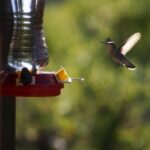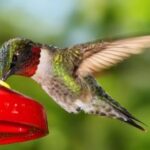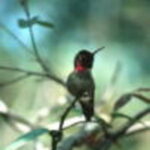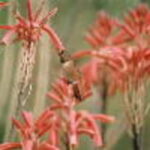With Georgia being a southern state, it only seems natural that there would be a good size population of hummingbirds who migrate through annually. In reality, nine species are seen and documented in Georgia regularly. These are Allen’s Hummingbird, Anna’s Hummingbird, Black-chinned Hummingbird, Broad-billed Hummingbird, Broad-tailed Hummingbird, Calliope Hummingbird, Magnificent Hummingbird, Ruby – throated Hummingbird and the Rufous Hummingbird.
Residents and visitors alike spend many hours enjoying these little, beautiful, interesting birds, some of these people may even have the urge to be capable of identifying the particular species of hummingbirds that spend time at their feeders or in their carefully planned and managed hummingbird garden. For those people who are interested in identifying the different species of hummingbirds who choose to visit them they should keep in mind that most of the identifying marks are actually the color of the feathers that cover their little tiny bodies.
The Allen’s Hummingbird is identified by metallic bronze-green feathers covering the back and head of the male as well as iridescent coppery-red feathers covering the throat. The female Allen’s Hummingbird is identifiable by the white feathers that cover its breast, a throat that is white with red spots, rufous colored feathers covering their back and sides and round white-tipped tail feathers.
The Anna’s Hummingbird is identifiable by a gray breast, the male being darker than the female, a green back on the female and a metallic green back on the male, a dark red throat and crown on the male and a white throat with red spots on the female. The female also has white-tipped tail feathers. The main identifying characteristic that sets the Allen’s Hummingbird apart from other hummingbird species is that the Allen’s Hummingbird has a song.
The Black-chinned Hummingbird gets its name from the black feathers that cover the throat of the male. The male Black-chinned Hummingbird also has a purple throat band, a white collar and a green breast, crown and back. The female Black-chinned Hummingbird has black spots on a white throat, a white breast, a green back and crown and buff sides.
The Broad-billed Hummingbird has quite a difference between the male and the female. The male has a brilliant metallic blue throat, a black tip on its red-orange bill and dark green feathers that cover its back, crown and breast. The female Broad-billed Hummingbird is not as bright and colorful as the male. The female has gray feathers covering its throat and breast, green feathers covering it is back and crown, a red-orange bill and white-tipped tail feathers.
The Broad-tailed Hummingbird is often distinguished from other hummingbirds by the unmistakable sound made by the wings of the male. This species is also identified by the colors of the feathers that cover the body. The male has metallic green feathers covering its crown and back, white feathers covering its breast, iridescent red feathers covering its throat and it has rounded tail feathers. The female also has green feathers that cover its crown and back, but they are not as bright as the male’s metallic colored feathers. The female also has white feathers covering its throat and breast, rusty colored feathers down its sides and a tail that has green feathers in the middle while the outer feathers are rufous at the base with white tips. These hummingbirds have been seen in Georgia during the winter hummingbird season, which generally runs from mid-November to late in April.
The Calliope Hummingbird is the smallest hummingbird to visit Georgia. These tiny hummingbirds weigh approximately 2.5g to 2.8g with males being the smaller of the sexes. Other than its size, this species of hummingbird can be identified by the color and location of feathers just like the other species. The male Calliope Hummingbird has metallic green feathers covering its crown and back, white feathers covering its throat with purplish red rays causing a whiskered effect. The female also has the green feathers covering its back and crown, but they are not as brilliant as the males, just like many other species of hummingbirds. The females also have white feathers covering their throats with darker feathers streaking the throat. They will also have buff feathers down their sides and white-tipped tail feathers. Buff-bellied Hummingbirds visit Georgia during the summer hummingbird season, which generally goes from early March to mid-October.
The Magnificent Hummingbird is another hummingbird species that can be identified by its size. Male Magnificent Hummingbirds average about 7.7g while the females are somewhat smaller, usually close to 6.4g. As with most hummingbird species, the male Magnificent Hummingbird is the more colorful of the sexes. These birds have dark green feathers covering their crown, metallic green feathers covering their throats, black feathers covering their breast and upper belly. Their lower belly is covered with brown feathers and they have notched, dark green tail feathers. This species of hummingbird is also a summer visitor to Georgia.
The Ruby-throated Hummingbird is one of the most common hummingbird species in the United States. Its ruby colored throat, its gray colored flanks and its forked tail are characteristics that can be used to identify the male Ruby – throated Hummingbird. The female Ruby-throated Hummingbird has a white colored breast and throat along with a white-tipped, rounded tail. Both sexes have emerald green backs. Hummingbird enthusiasts in Georgia can expect to see these hummingbirds during the summer season, usually from early March to mid-October. They may even be lucky enough to have a nest built and babies hatch out.
The Rufous Hummingbird is undoubtedly the quickest of the hummingbird species seen in Georgia. The male Rufous Hummingbird is distinctly identified by its rufous feathers that cover its back, crown, tail and flanks, almost its entire body. However, it does, have bright orange-red feathers on its throat and white feathers on its breast. The female of this species does not resemble the male at all; it more closely resembles the female Allen’s Hummingbird. The female has green feathers covering its back and crown, white breast feathers, a white throat with red spots, rufous flank feathers and a tail that has feathers that are rufous at the base and are white-tipped. Rufous Hummingbirds are winter visitors to Georgia, usually being seen from November to March.
Now that the hummingbirds that visit Georgia have been identified, it might be nice to know what a person can do to attract them to their garden. To begin with, hummingbirds are very particular when it comes to the plants which they choose to get nectar. These plants include shrubs and trees, vines, perennials and of course, annuals. The shrubs and trees most likely to attract hummingbirds to a garden in Georgia are Azaleas, Blueberry, Butterfly Bush, Hibiscus, Mexican Cigar, Rhododendron, Tulip Popular, Wax Myrtle, Weigelia, Wild Azaleas, Winter Honeysuckle. The vines most likely to be preferred by hummingbirds are Creeper, Coral honeysuckle, Cross Vine. The perennials are and the annuals are Cardinal Flower, Columbine, Coral Bells, Crocosmia, Day Lily, Foxglove, Hosta, Indian Pink, Lantana, Liatris, Monarda (Bee Balm), Penstemon, Salvia and Sages and the annuals are Impatiens, Jewelweed, Milkweed, Petunia, Ruellia, Zinnia. With a garden carefully designed to include some of these plants along with a few feeders, hummingbird enthusiasts should be set for year round visits from these tiny birds.









